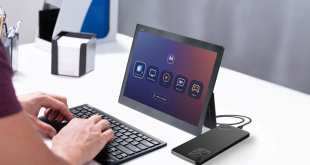Jason Turner, business innovation director at AVMI talks about how Microsoft’s Surface Hub has the potential to be the perfect solution for the modern workspace.
It’s fair to say that Microsoft’s Surface Hub didn’t get off to the best of starts, with those initial shipping delays, stock shortages, price increases, and – it’s reported by some – technical glitches. But more than two years on from its unveiling in January 2015, Surface Hub is finally beginning to fulfil its promise.
The 55- and 84-inch touch-screen AV/IT solution was designed for today’s new breed of workspaces, combining several essential conference room components into one collaborative device. Microsoft, reckons it adds “the best group productivity and collaboration device to the most productive personal devices in the world”.
Bringing together applications such as Windows 10, Office and Skype for Business, Surface Hub is designed around a highly responsive screen built for ink and touch. Both models are integrated with optically bonded displays capable of detecting 100 points of multi-touch and up to three simultaneous pen inputs. They also boast dual 1080p front-facing video cameras, and a four-element microphone array that detects and follows voice to eliminate background noise during VC sessions. In addition, there’s built-in Wi-Fi, Bluetooth 4.0, NFC and various ports for wired and wireless connectivity options, allowing devices to easily share content to the screen.
For me where the device stands out is in its the ability to get meetings started from the moment you walk in the room – up and running within seconds of touching the screen. Microsoft calls it ‘Walk up and use’ and it is exactly that – one of the Surface Hub’s major plus points. Typically, the time taken to set up meeting rooms is between 8 and 15 minutes: the ‘normal user experience’ of a meeting space. Surface Hub smashes that.
Only limited by what users want to do with it or the applications they want to use on it, the Hub is an essential deployment tool for today’s modern workspaces. I believe it to be a game-changer. Benefits included improved meeting productivity – specifically for initiating meetings with remote participants and handling post-meeting tasks – reduced meeting room equipment costs and no printing costs, and improved results from client meetings, leading to bigger and better sales.
Microsoft developed the Surface Hub to fit neatly into its Cloud strategy, but also to be able to be used in conjunction with legacy solutions until such time as clients migration to Cloud in the future. It natively works with Microsoft Skype and Office 365. But it really is the simplicity of use that is the true benefit.
But it’s not just easy to use: it’s easy to integrate into existing systems too. The Hub is designed to work with existing customer networks, but all you have to do is drop in an Office 365 license and you’re up and running – super fast and super flexible. If the end user has his own Office 365 estate in place already, the Surface Hub is just added as a device into that existing estate.
One of the great things about the Surface Hub is that it allows for Windows 10 universal applications to be run on it, allowing you to download workflow, business use and collaboration/design apps from the various stores. Customers may wish to develop their own apps, of course.
Ultimately, Surface Hub is only limited by what users want to do with it or the applications they want to deploy. It’s quick and easy to integrate and use, cost-effective and super-flexible with huge scope for expanded usage. The plug-and-play UC and collaboration device the world has been waiting for.
 PCR Tech and IT retail, distribution and vendor news
PCR Tech and IT retail, distribution and vendor news



